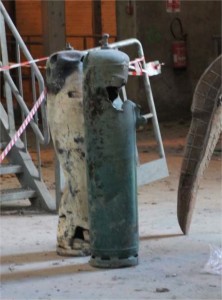Two 35-kg propane cylinders that had been mixed with bulky waste exploded at 11:53 a.m. inside the compactor of a waste incineration plant. The blast blew off part of the building’s cladding and triggered a fire in the pit, which was filled with 2200 t of waste. The compactor was shut down and the grab cranes over the pit moved to their fallback positions. The sprinkler system, pit monitor and a water-additive fire hose reel were used to fight the flames. The firefighters arrived 20 min later and used significant additional resources to fight the partially contained fire. The fire, which emitted black smoke through the gutted cladding, was extinguished at around 1:00 p.m. The inspection authorities for classified facilities were informed. The incinerator, which was not damaged or shut down, was authorised to resume normal operations. The extinguishing water was absorbed by the waste in the pit.
The plant operator secured the exterior and roof components that were hanging or at risk of falling and had the compactor inspected before putting it back in service. It also replaced the two metal gates of the press, which had been deformed by the blast, reconfigured the damaged pit smoke detectors and repaired the cladding on the facilities.
The bulky waste that caused the fire had been collected directly from homes in the area. The operator reminded all the surrounding communities which types of waste are not accepted by the plant. It implemented procedures for visually checking waste emptied into the pit and bulky waste sent to the compactor.
To reduce the risk for people, it now prohibits anyone being present in the hazard area around the compactor when it is in operation (indicated by a flashing beacon). It also moved the compactor’s local controls to the control room so that it can be unjammed remotely. Lastly, it modified the compactor to reduce jamming requiring manual intervention.
The pit monitor made it possible to quickly attack the fire. The operator supplemented it with a second monitor (additional angle of attack) that is controlled by the pit scanner (used to detect rises in temperature).




